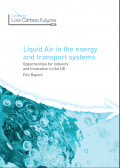Compared to 1990 levels, Birmingham and the wider urban area could reduce its carbon emissions by 2022 by 10.8% through cost effective investments that would pay for themselves (on commercial terms) over their lifetime.
Research Reports
The Economics of Low Carbon Cities: A Mini-Stern Review for Birmingham and the wider urban area
September, 2013
New Climate Alliances

August, 2013
The range of actors who encounter climate change adaptation and mitigation in their everyday experiences, and the levels of scales at which climate issues are experienced and tackled, go far beyond national governments. This report explores the new climate alliances emerging in the absence of an ambitious international framework.
Liquid Air in the Energy and Transport Systems (Executive Summary)

May, 2013
One of the biggest challenges of decarbonisation is to develop new energy vectors. The Executive Summary introduces liquid air as an increasingly attractive opportunity and provides key recommendations for policymakers, business and researchers.
Liquid Air in the Energy and Transport Systems (Full Report)
May, 2013
One of the biggest challenges of decarbonisation is to develop new energy vectors. This report describes how liquid air is produced, and introduces the new technologies being developed to exploit it as an energy vector.
Carbon Capture and Utilisation in the Green Economy
April, 2013
Using CO2 to manufacture fuel, chemicals and materials.
The Economics of Low Carbon Cities: A Mini-Stern Review for the Sheffield City Region
March, 2013
The Sheffield City Region has an energy bill of £3.4 billion a year, forecast to grow to £4.59 billion by 2022. SCR could insulate itself against 61% of projected energy price increases by investing in the cost-effective low carbon measures identified in this report.
The Economics of Low Carbon Cities: A Mini-Stern Review for the Humber

January, 2013
What is the most effective and efficient way to decarbonise a city? There are hundreds of low carbon options available, with a potential to offset increases in the Humber's energy bill by 96% of the projected increase by 2022.
Food Security: Near Future Projections of the Impact of Drought in Asia

October, 2012
This ground-breaking analysis from a lead IPCC author examines the probable impacts of climate change-driven drought on crop production across Asia in the 2020s, and assesses the vulnerability and adaptive capacity of each country.
Carbon Capture: A Technology Assessment

July, 2012
This techno-economic evaluation of power generation in the UK assesses performance of the introduction of CCS technologies on three UK power generation sectors - solid fuel, integrated gas combined cycle and natural gas combined cycle.
Funding Low Carbon Cities: Mapping the Risks and Opportunities

July, 2012
This paper provides a contemporary account of how UK local authorities might approach the question of how to ensure the funding of retrofits and investments in low carbon options, with a particular focus on the major obstacles that need to be overcome and the key financial and non-financial risks that need to be managed.
- ‹ previous
- 2 of 4
- next ›
Featured report

The Economics of Low Carbon, Climate Resilient Cities - Lima-Callao, Peru
The Lima-Callao area has a population of 9 million andan economy worth US$66 billion in 2014. The preliminary results of our research indicate that the total energy bill for the city was US$4.7 billion and that the bill for waste and water was US$50 billion - meaning that 8% of everything earned in the local economy was spent on energy, water and waste.





